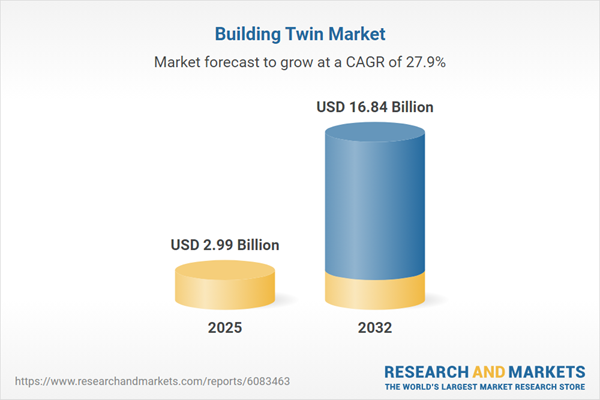Speak directly to the analyst to clarify any post sales queries you may have.
Senior leaders in the built environment face complex demands for greater efficiency, risk management, and sustainable value. The building twin market introduces transformative tools, integrating digital innovation seamlessly into operational processes to drive smarter asset management and resilient business outcomes.
Building Twin Market Snapshot
The building twin market is expanding rapidly, propelled by a fundamental shift toward data-driven operations and advanced analytics. Organizations are harnessing real-time facility insights to support strategic sustainability objectives, optimize costs, and respond quickly to operational challenges. The integration of digital twin platforms is increasingly central in sectors managing complex or aging infrastructure, where technology convergence is pivotal to future-ready facility management. This growth is supported by widespread adoption across building portfolios, from commercial to industrial settings, as owners and operators prioritize digital reconstruction to stay competitive and compliant.
Scope & Segmentation: Building Twin Market
- Component: Hardware includes connectivity tools, sensor systems, and controllers. Software spans analytics, simulation, and visualization. Services cover consulting, implementation, and maintenance—together supporting integration and ongoing value delivery.
- Deployment Type: Solutions are available for cloud or on-premises deployment, allowing organizations to match security, scalability, and integration needs with tailored environments.
- Application: Key use cases drive outcomes in energy management, optimizing space, enhancing safety and security, and overseeing comprehensive facility operations. These solutions help organizations achieve both operational efficacy and sustainability targets.
- End User: Building twin adoption is relevant to commercial properties, educational and healthcare institutions, industrial operations, and residential portfolios, enabling organizations to address unique asset challenges and opportunities.
- Building Type: Platforms are adopted across office spaces, residential complexes, industrial facilities, healthcare environments, retail, and hospitality settings, each demanding solutions to specific operational pressures.
- Geographic Coverage: The analysis covers the Americas—including the United States, Canada, and leading economies in Latin America; Europe; Middle East and Africa—including the UK, Germany, France, and select African countries; Asia-Pacific markets, with a focus on China, India, and Japan.
- Leading Companies: Major market players include Microsoft, Siemens, IBM, Schneider Electric, Autodesk, Bentley Systems, Dassault Systèmes, PTC, Amazon, and Hexagon, providing advanced analytics, data management, and facility integration expertise.
Key Takeaways for Senior Decision-Makers
- Digital twin platforms are evolving as predictive and adaptive tools through the convergence of artificial intelligence, IoT, and cloud computing, allowing continuous alignment with changing business needs.
- Holistic asset and facility management is strengthened by the adoption of building twin solutions, supporting streamlined maintenance, improved compliance, and enhanced stakeholder experience in support of sustainability mandates.
- Rapid advances in modular sensor technology, edge computing, and the adoption of open standards accelerate digital transformation, enabling flexible and staged implementations across various facility footprints.
- Regulatory requirements related to net-zero targets and energy efficiency act as strong drivers for technology adoption, especially in markets undertaking large-scale retrofits or modernization efforts.
- Strategic alliances, innovation in visualization and analytics, and targeted acquisitions extend organizational capacity to integrate and extract value from complex facility data within unified platforms.
Tariff Impact on the Building Twin Ecosystem
Recent United States tariffs on imported hardware have prompted significant adaptation among building twin providers. Companies are localizing manufacturing, redesigning hardware, and prioritizing modular, cloud-native solutions. These efforts stabilize end-user pricing and address supply chain and trade policy uncertainties, helping businesses to maintain continuity amid ongoing global shifts.
Methodology & Data Sources
This market research leverages a rigorous mixed-methods approach. Secondary research draws on industry publications, patents, and regulatory frameworks, while executive interviews provide strategic perspectives. All findings are validated through triangulation with financial statements, press releases, and peer-reviewed sources to ensure robust, objective insights.
Why This Report Matters
- Enables senior leaders to benchmark the adoption of building twin technology, inform technology strategy, and prioritize operational improvements across multi-sector portfolios and regions.
- Delivers actionable guidance for managing supply chain risk and adapting to evolving regulatory demands in facility modernization initiatives.
- Offers clear pathways for investing in modular technology and developing talent to unlock greater digital transformation value and faster returns.
Conclusion
Building twin solutions are reshaping asset and facility management amid changing regulatory and operational requirements. This report delivers targeted insights to guide executive strategy as organizations progress in their digital transformation journey.
Table of Contents
3. Executive Summary
4. Market Overview
7. Cumulative Impact of Artificial Intelligence 2025
Companies Mentioned
The companies profiled in this Building Twin market report include:- Microsoft Corporation
- Siemens Aktiengesellschaft
- International Business Machines Corporation
- Schneider Electric SE
- Autodesk, Inc.
- Bentley Systems, Incorporated
- Dassault Systèmes SE
- PTC Inc.
- Amazon.com, Inc.
- Hexagon AB
Table Information
| Report Attribute | Details |
|---|---|
| No. of Pages | 183 |
| Published | October 2025 |
| Forecast Period | 2025 - 2032 |
| Estimated Market Value ( USD | $ 2.99 Billion |
| Forecasted Market Value ( USD | $ 16.84 Billion |
| Compound Annual Growth Rate | 27.9% |
| Regions Covered | Global |
| No. of Companies Mentioned | 11 |









